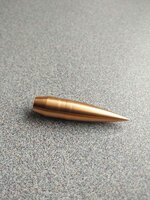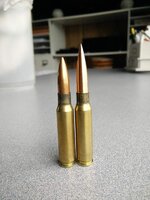Anyone who follows the "Precision" blogs or shooters of the world have read the hype.
Ultra-high BC, able to be pushed faster than traditional, leaps tall buildings in a single bound....
I bought a box of the .308. 155.5gr bullets. Let me say that Mr. Warner, who builds them is a fine gentleman. The Precision buffoons who promote them are another story.
Bullet length = 1.447"
Front driving band width = .093"
Back band length = .205"
Shank diameter = .301"
Driving band Diameter = .309" - which is the same as my 175 SMK's.
Cartridge OAL to lands = 3.227"** this is ROUGHLY, simply because I didn't get a really good "feel" for the lands and this was seated about the same width as the front driving band. So I called it close enough, seated the bullets the standard .03125" deeper and called it game.
Due to this, they benefitted immensely from using my FCD.



The middle picture is against a 175SMK that I shoot to a mile.
The bottom is a line up of:
175SMK -308
140SMK -264
142SMK -264
140 Berg Hybrid -264
155 FLATLINE 308
In the original Precision blog I read about these, it was suggested that due to the general magic associated with them, you would need to step up to a fast powder and load as though it were a whole class lighter bullet. So load for a 130-class bullet. Specifically it has been said anything short of 4895 is too slow and would produce very low velocities. So I used a load of CFE that I have very detailed info on, used behind 150gr SMK's; "slow is bad" bedamned. On a 6 shot average(Same powder lot) the FL bullets were very consistent in being only about 30fps slower than the 150SMK's.
Short of a strain guage system, the best way to tell pressures is velocity, so this isn't looking good for the magic.
These do happily stabilize in my 10-twist, however.
I have a bunch of Pressure testing with them in progress, so a wee bit O'time will confirm. And will be able to confirm or debunk this claim about speed with 4895.
The tail angle and CG/CP will almost certainly prevent them from safely crossing Trans-sonic, but I will also test that very shortly.
Ultra-high BC, able to be pushed faster than traditional, leaps tall buildings in a single bound....
I bought a box of the .308. 155.5gr bullets. Let me say that Mr. Warner, who builds them is a fine gentleman. The Precision buffoons who promote them are another story.
Bullet length = 1.447"
Front driving band width = .093"
Back band length = .205"
Shank diameter = .301"
Driving band Diameter = .309" - which is the same as my 175 SMK's.
Cartridge OAL to lands = 3.227"** this is ROUGHLY, simply because I didn't get a really good "feel" for the lands and this was seated about the same width as the front driving band. So I called it close enough, seated the bullets the standard .03125" deeper and called it game.
Due to this, they benefitted immensely from using my FCD.



The middle picture is against a 175SMK that I shoot to a mile.
The bottom is a line up of:
175SMK -308
140SMK -264
142SMK -264
140 Berg Hybrid -264
155 FLATLINE 308
In the original Precision blog I read about these, it was suggested that due to the general magic associated with them, you would need to step up to a fast powder and load as though it were a whole class lighter bullet. So load for a 130-class bullet. Specifically it has been said anything short of 4895 is too slow and would produce very low velocities. So I used a load of CFE that I have very detailed info on, used behind 150gr SMK's; "slow is bad" bedamned. On a 6 shot average(Same powder lot) the FL bullets were very consistent in being only about 30fps slower than the 150SMK's.
Short of a strain guage system, the best way to tell pressures is velocity, so this isn't looking good for the magic.
These do happily stabilize in my 10-twist, however.
I have a bunch of Pressure testing with them in progress, so a wee bit O'time will confirm. And will be able to confirm or debunk this claim about speed with 4895.
The tail angle and CG/CP will almost certainly prevent them from safely crossing Trans-sonic, but I will also test that very shortly.













